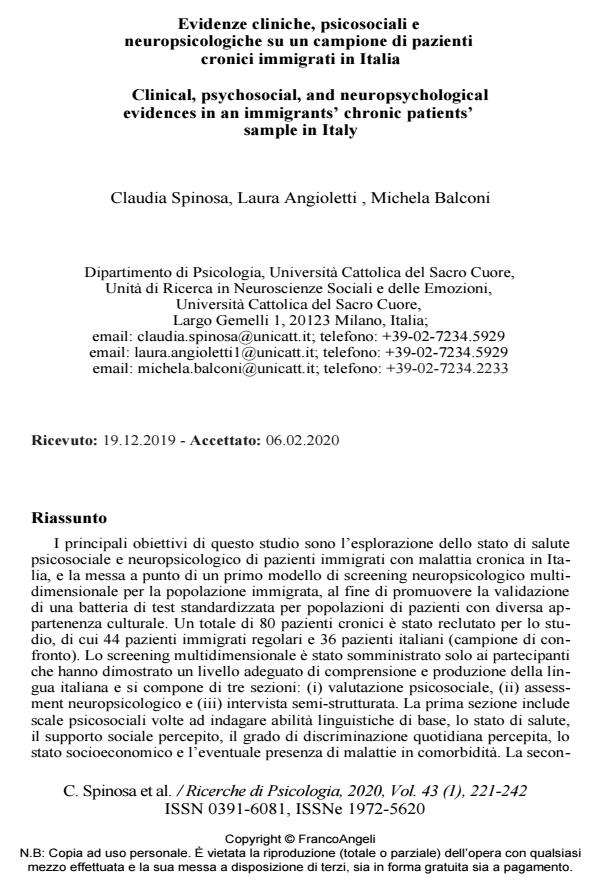Clinical, psychosocial, and neuropsychological evidences in an immigrants’ chronic patients’ sample in Italy
Journal title RICERCHE DI PSICOLOGIA
Author/s Claudia Spinosa, Laura Angioletti, Michela Balconi
Publishing Year 2020 Issue 2020/1
Language Italian Pages 22 P. 221-242 File size 258 KB
DOI 10.3280/RIP2020-001010
DOI is like a bar code for intellectual property: to have more infomation
click here
Below, you can see the article first page
If you want to buy this article in PDF format, you can do it, following the instructions to buy download credits

FrancoAngeli is member of Publishers International Linking Association, Inc (PILA), a not-for-profit association which run the CrossRef service enabling links to and from online scholarly content.
The main aims of this study are to explore the psychosocial and neuropsychological state of health of immigrant patients with chronic disease in Italy, and the development of a first multidimensional neuropsychological screening model for the immigrant population, to promote the validation of a standardized set of tests for populations with different cultural backgrounds. A total of 80 chronic patients were enrolled in the study, including 44 regular immigrant patients and 36 Italian patients (control sample). The multidimensional screening was administered only to participants who demonstrated an adequate level of understanding and production of the Italian language and it was based on three sections: (i) psychosocial evaluation, (ii) neuropsychological assessment and (iii) a semi-structured interview. The first section includes psychosocial scales aimed at investigating basic language skills, health status, perceived social support, the degree of daily perceived discrimination, the socio-economic status and the presence of comorbidity with other clinical disorders. The second section consists of a battery of neuropsychological tests evaluating global cognitive functioning. The semi-structured interviews were recorded and analysed with the method of the agreement between the judges. Psychosocial findings showed that chronic immigrant patients are significantly younger than Italians, perceive greater discrimination and less social support, especially by the family, than Italian patients. Neuropsychological data showed that the chronic immigrant sample appears to be cognitively vulnerable, particularly in short-term auditory-verbal memory and non-verbal abstract reasoning, compared to the Italian sample. The analysis of the interviews reveals some differences were found for the topics referred by all patients, such as, the experience within the outpatient and/or hospital services, that the foreign chronic sample describes as better than the Italian sample.
Keywords: Chronic disease, immigrants, multidimensional evaluation, quali-quantitative research, neuropsychological screening.
- What about health representation in healthcare professionals toward immigrant chronic patients: a new tool for discourse analysis Laura Angioletti, Claudia Spinosa, Michela Balconi, in Journal of Public Health /2023 pp.381
DOI: 10.1007/s10389-021-01518-w - Migrazioni e psicologie. Introduzione al Forum Alessandro Antonietti, Antonella Marchetti, in RICERCHE DI PSICOLOGIA 1/2020 pp.13
DOI: 10.3280/RIP2020-001002
Claudia Spinosa, Laura Angioletti, Michela Balconi, Evidenze cliniche, psicosociali e neuropsicologiche su un campione di pazienti cronici immigrati in Italia in "RICERCHE DI PSICOLOGIA " 1/2020, pp 221-242, DOI: 10.3280/RIP2020-001010